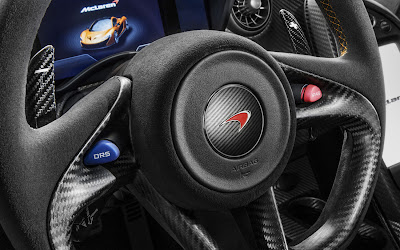Official: McLaren P1 Produces 903 HP From Twin-Turbo V-8, Electric Drivetrain After releasing several rounds of teaser photos, McLaren has finally revealed some technical details on its new P1 supercar. The McLaren P1 uses a modified version of the twin-turbo V-8 engine from the MP4-12C supercar, supplemented with an electric motor that provides extra power for acceleration.
Official: McLaren P1 Produces 903 HP From Twin-Turbo V-8, Electric Drivetrain
 |
| Official: McLaren P1 Produces 903 HP From Twin-Turbo V-8, Electric Drivetrain |
Official: McLaren P1 Produces 903 HP From Twin-Turbo V-8, Electric Drivetrain
 |
| Official: McLaren P1 Produces 903 HP From Twin-Turbo V-8, Electric Drivetrain |
Official: McLaren P1 Produces 903 HP From Twin-Turbo V-8, Electric Drivetrain
The twin-turbo 3.8-liter V-8, named the M838T, has been modified for better cooling and durability, as well as more power. It’s rated for 727 hp and 531 lb-ft of torque, the latter available from 4500 rpm. An electric motor/generator, integrated with the engine, can add another 176 hp and 192 lb-ft of torque. A 212-pound battery pack sits between the passenger compartment and engine bay, storing enough charge for the McLaren P1 to drive 6.2 miles with the gasoline engine turned off. When both power units work together, their combined output is 903 hp and 664 lb-ft.
The engine and motor turn a seven-speed dual-clutch transmission that, in turn, powers the rear wheels. McLaren uses the electric motor to slow down the gas engine during upshifts, dropping engine revs more quickly and allowing for slightly faster gear changes.
McLaren also announced two technologies for the P1 road car that are inspired by its Formula 1 cars, both of which are activated by steering-wheel buttons. The Drag Reduction System adjusts the angle of the rear wing to reduce aerodynamic drag by 23 percent, helping improve straight-line performance. But the wing returns to its normal position for better downforce when the driver releases the button or applies the brakes. The IPAS, or Instant Power Assist System, instructs the car to direct all available battery power to the motor for a “push-to-pass”-like feature — while it may quickly drain the battery, it will also provide a surge of extra power.
The electric motor acts as a generator when braking or coasting to recharge the car’s battery pack for the next burst of acceleration. It can also be juiced up by plugging in to a charger when the car is parked. In other words, the McLaren P1 supercar is technically a plug-in hybrid.
Included teaser photos reveal that, as we had gathered from previous press pictures, the McLaren P1 will have a wild body with a narrow, tapered greenhouse; a low nose; a convoluted rear diffuser with center-exit exhaust; and a tall rear wing. The McLaren P1 will make its debut in March at the Geneva Motor Show.
Source: McLaren
The engine and motor turn a seven-speed dual-clutch transmission that, in turn, powers the rear wheels. McLaren uses the electric motor to slow down the gas engine during upshifts, dropping engine revs more quickly and allowing for slightly faster gear changes.
McLaren also announced two technologies for the P1 road car that are inspired by its Formula 1 cars, both of which are activated by steering-wheel buttons. The Drag Reduction System adjusts the angle of the rear wing to reduce aerodynamic drag by 23 percent, helping improve straight-line performance. But the wing returns to its normal position for better downforce when the driver releases the button or applies the brakes. The IPAS, or Instant Power Assist System, instructs the car to direct all available battery power to the motor for a “push-to-pass”-like feature — while it may quickly drain the battery, it will also provide a surge of extra power.
The electric motor acts as a generator when braking or coasting to recharge the car’s battery pack for the next burst of acceleration. It can also be juiced up by plugging in to a charger when the car is parked. In other words, the McLaren P1 supercar is technically a plug-in hybrid.
Included teaser photos reveal that, as we had gathered from previous press pictures, the McLaren P1 will have a wild body with a narrow, tapered greenhouse; a low nose; a convoluted rear diffuser with center-exit exhaust; and a tall rear wing. The McLaren P1 will make its debut in March at the Geneva Motor Show.
Source: McLaren


